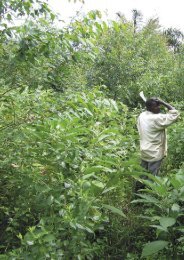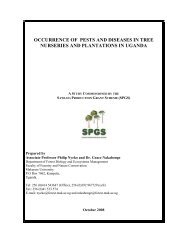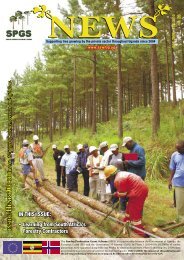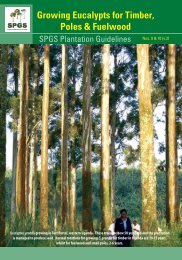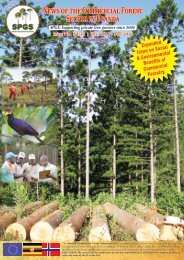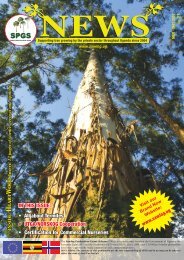download - SPGS
download - SPGS
download - SPGS
You also want an ePaper? Increase the reach of your titles
YUMPU automatically turns print PDFs into web optimized ePapers that Google loves.
SAWLOG PRODUCTION GRANT SCHEME - MAY - JULY 2009. ISSUE NO. 24<br />
and following technical guidelines).<br />
• Attending <strong>SPGS</strong> Clients meetings, to learn from good and<br />
bad practices in the field.<br />
• If an opportunity to visit South Africa or any other country<br />
that has excelled in commercial tree planting arises,<br />
simply take it up.<br />
Next we have the thoughts of Engineer Hilary Kakeeto and CD<br />
Langoya - Maximizing timber productivity through<br />
silvicultural operations.<br />
Plantation forestry has played a major role in the development<br />
of the South African economy.<br />
It is estimated that over 1.3 M<br />
ha of commercial plantations<br />
have been established mainly<br />
to meet the growing domestic<br />
demands for construction,<br />
mining and the pulp industries.<br />
The two major sawlog timber<br />
trees are Pinus patula and<br />
Eucalyptus grandis.<br />
Initial spacing<br />
Planting<br />
(trees/ha)<br />
Although there are<br />
differences in climatic<br />
condition and soil variations, productivity per<br />
unit area of any plantation is maximized through<br />
silvicultural operations. It was observed that economic return<br />
is the driving force in the forestry enterprise: a lesson that<br />
timber growers in Uganda should learn. The following are<br />
the key silvicultural observations to note from S. Africa:<br />
Planning is the most important single operation in forestry<br />
enterprise and each business operation/unit has a planner who<br />
draws out long-term plans (10-30 years), mid-term (5 years)<br />
and short-term plans (yearly, quarterly, monthly and weekly).<br />
The plans are then passed to the department or contractors<br />
who will execute them. An officer is assigned to monitor the<br />
implementation of the plan and quality assurance.<br />
Comprehensive survey and zoning of the area to be<br />
planted is done and where trees are going to be planted, the<br />
site index is determined which in turn will help in predicting<br />
mean annual increment (MAI). Water courses and area of<br />
biodiversity importance are preserved in its natural state.<br />
Procurement of seedlings has been from renowned<br />
nursery operators and all the timber companies visited pay<br />
top dollars for quality seedlings. Their argument is that if you<br />
buy poor quality seedlings now, you will be stuck with them<br />
for 10 – 28 years. Because of the demand for top quality<br />
planting materials, planting materials are delivered as far<br />
as over 150 Km from the nurseries. The nursery operators<br />
visited take tree breeding very seriously as it is the foundation<br />
for forestry in S. Africa and as a business enterprise for them.<br />
For example, Eucalyptus cloned mother gardens are replaced<br />
every 5 years.<br />
Planting out is undertaken at a large scale (20-30 ha per<br />
day on average) and it is done between 6:00am – 3:00pm. In<br />
order to extend the planting period, it is done with water (2<br />
lts per tree) or aqua-soil (0.5lt when the soil wet or 1lt when<br />
dry). The use of aqua-soil yields better results.<br />
Pruning is done to improve on the quality of the timber.<br />
Pruning regime is determined by the height of the trees which<br />
is influenced by the site index of the land. Rich and deep<br />
soil encourages faster growth and hence taller trees. In South<br />
Africa, they prune trees for timber and poles up to 9-10m in<br />
stages or ‘lifts’ depending on how fast the crop is growing.<br />
Thinning is undertaken to reduce plant population per<br />
hectare. This is done because the plantation manager would<br />
like to maximum volume and timber recovery per hectare<br />
(maximize income per tree). In South Africa, early and heavy<br />
thinning in both eucalypts and pine is the order of the day as<br />
seen in the table below:<br />
1st thinning 2nd thinning 3rd thinning Final harvest<br />
– avg. vol.<br />
York Timber: P. patula yr 6 yr 12 yr 18 yr. 24-26<br />
3 x 3 m 1,111 650 400 250-270 350-400m 3 /ha<br />
Peak Timber: E. grandis 1.5 6 9 18<br />
3.3 x 3.3 m 918 500 400 250 220-300m 3 /ha<br />
Merensky: E. grandis 2 6 9 16-22<br />
3 x 3 m 1,111 625 375 275 340m 3 /ha<br />
Weeding: We learned that 70% of stress in young trees<br />
occurs in the first year and the major cause is weed. Every<br />
effort has to be made to control weeds at all cost during<br />
the first year and hence every planting operation should be<br />
planned to match with ability to control weeds.<br />
In conclusion, the message from South African forestry is that<br />
economics should be the driving force for forestry enterprise<br />
expansion. This calls for integrated planning, aggressive<br />
silvicultural operations and investing in tree breeding.<br />
Protection of fragile ecosystems within the plantations is<br />
very important as well.<br />
Boaz Tishekwa and Gershom Onyango were impressed by –<br />
The use of fire in plantation management.<br />
Fire can be both a problem and an asset to plantation forestry<br />
establishment and management, depending on how it is used<br />
or the circumstances. Our visit to South Africa and Swaziland<br />
exposed us to fire management operations of various degrees<br />
of sophistication. We learnt that fire danger is unpredictable<br />
and we need to be alert at all times to minimize the loss from<br />
fires.<br />
South Africa has state of the art fire fighting systems.<br />
However, despite all the sophistication, the country suffered<br />
heavy losses of its forest plantations estimated at 130,000<br />
hectares and millions of Rand during 2007 and 2008. This<br />
shows how serious fire can be and the loss it can cause to<br />
investments in forest plantations. For the private tree growers<br />
in Uganda this is an area that requires a lot of attention given<br />
our rudimentary fire fighting methods and equipment. In<br />
South Africa, the main cause of forest fires is lighting while<br />
in Swaziland like in Uganda, the main cause is man.<br />
A visit to Tweefontein in South Africa provided us with an<br />
opportunity to see a state of the art fire fighting system.<br />
The fire fighting company had twenty four cameras that are<br />
located at strategic points. These provide surveillance over<br />
a 250 km radius and are all linked to one command centre<br />
where information from the cameras is stored in computers.<br />
Operators in the command centre can zoom in on any area<br />
Cont’d on p. 13<br />
NEWS OF UGANDA’S COMMERCIAL TREE PLANTING FUND FOR THE PRIVATE SECTOR<br />
7



